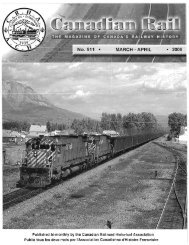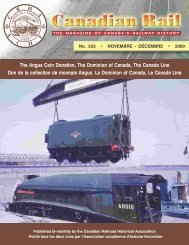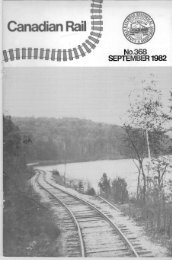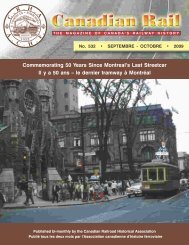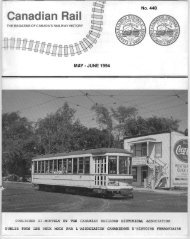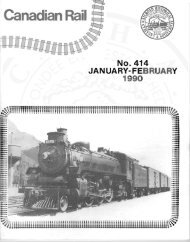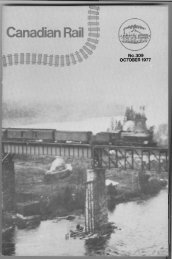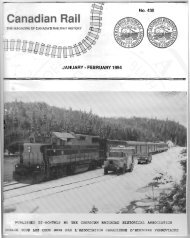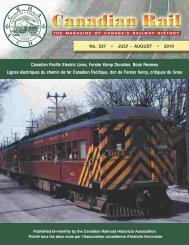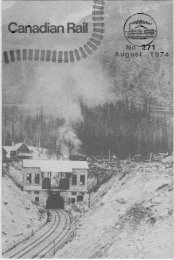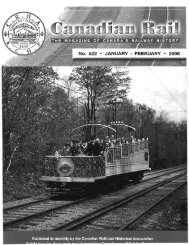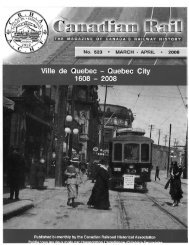Canadian Rail_no525_2008 - Le musée ferroviaire canadien
Canadian Rail_no525_2008 - Le musée ferroviaire canadien
Canadian Rail_no525_2008 - Le musée ferroviaire canadien
You also want an ePaper? Increase the reach of your titles
YUMPU automatically turns print PDFs into web optimized ePapers that Google loves.
JULY - AUGUST <strong>2008</strong><br />
131 CANADIAN RAIL· 525<br />
A Concise History<br />
of the CRHA<br />
By Stephen Wray and Peter Murphy<br />
Part 3<br />
THE MUSEUM ERA<br />
The acquisition of two wheel and axle sets from a<br />
primitive coal car of the Albion <strong>Rail</strong> Road which began<br />
serving the mines of the General Mining Association in<br />
the Stellarton, Nova Scotia area in the 1830s, a signal mast<br />
from the Eastern Townships, and Montreal tram Number<br />
274 in 1950, motivated the CRHA to consider<br />
establishing a formal railway museum. Initial plans for a<br />
proposed museum were discussed between <strong>Le</strong>onard<br />
Seton, QC and Orner S.A. Lavallee in <strong>Le</strong>onard's living<br />
room in Lachine, Quebec. Other directors and members<br />
were approached and the project gathered steam.<br />
Meanwhile requests for donations of other streetcars<br />
were made and, in most cases, granted as early passenger<br />
cars employed as work cars in 1950were being scrapped.<br />
The <strong>Canadian</strong> National <strong>Rail</strong>ways collection<br />
began in 1955 when the Association requested one, and<br />
received two, Montreal and Sou them Counties<br />
interurbans - Number 104 and 611. These cars were still<br />
in regular service at that time! The M&SC was an<br />
interurban subsidiary of <strong>Canadian</strong> Na tional tha t provided<br />
commuter service from McGill Street in Montreal, across<br />
the Victoria Bridge, to St. Lambert, Marieville and<br />
Granby on Montreal's South Shore. On June 19, 1955 all<br />
M&SC operations on the Island of Montreal (McGill<br />
Street terminal) ended. Cars 104 and 611 were left behind<br />
at McGill Street; the other cars were either brought over<br />
to Saint Lambert for continued service, or scrapped at<br />
Pointe St. Charles. The MTC agreed to store the two<br />
interurbans at Youville shops along with the 274, which<br />
was already there. All M&SC operations ended in<br />
October 1956.<br />
Our first steam locomotive, E.B. Eddy 0-4-0T<br />
Number 2, was stored at G. M. Gest in Dorval, Quebec<br />
after its acquisition in 1956. The <strong>Canadian</strong> Pacific portion<br />
of the collection began in 1958, when the Association took<br />
possession of the Business Car "Saskatchewan", thereby<br />
preserving a vehicle that was used as the office of Sir<br />
William Cornelius Van Horne during the construction of<br />
much of the CPR in Western Canada.<br />
The "Saskatchewan" is one of the most<br />
significant pieces in the collection as it carried Sir William<br />
Van Horne, Sir Stanford Fleming and Donald A. Smi th to<br />
Craigellachie, British Columbia, to the driving of the last<br />
spike in the transcontinental line on November 7, 1885.<br />
After its arrival from Toronto, the Dominion Bridge<br />
Company in Lachine, Quebec provided temporary<br />
Un aper~u de<br />
l'histoire de l' ACHF<br />
Par Stephen Wray et Peter Murphy<br />
Texte traduit en fran~ais par Denis Vallieres,<br />
Traduction de descriptions de photos par Denis Latour<br />
Troisieme partie<br />
LEMUSEE<br />
En 1950, l'Association <strong>canadien</strong>ne d'histoire<br />
<strong>ferroviaire</strong> (ACHF) fit l'acquisition de deux roues et d'un<br />
essieu d'un ancien wagonnet de charbon que l'Albion<br />
<strong>Rail</strong> Road avait utilise vers 1830 pour les mines de la<br />
General Mining Association a Stellarton, en Nouvelle<br />
Ecosse, ainsi que d'un mat de signalisation provenant des<br />
Cantons de l'Est et d'un tramway de Montreal, Ie No 274.<br />
A la suite de ces achats, I' Association se pencha<br />
serieusement sur I'idee d'implanter un musee <strong>ferroviaire</strong>.<br />
Dans son salon a Lachine, au Quebec, <strong>Le</strong>onard Seton<br />
discuta ainsi longuement avec Orner S. A. Lavallee de<br />
divers plans de musee. D'autres administrateurs et<br />
membres se joignirent a eux et Ie projet prit de l'ampleur.<br />
Entretemps, on presenta des demandes de dons de<br />
tramways. Ces vehicules anciens ayant d'abord servi au<br />
transport de passagers et souvent, par la suite, a<br />
l'entretien, etaient souvent concedes puisque, en 1950, ils<br />
devaient de toute maniere etre demanteles.<br />
La collection du Canadien National debuta en<br />
1955 lorsque, apres avoir demande un tramway<br />
interurbain a la Montreal & Southern Counties,<br />
l'Association en re~ut deux, les Nos 104 et 611, qui etaient<br />
d'ailleurs encore en service! La M&SC Mait une filiale<br />
du CN et fournissait un service de transport de banlieue :<br />
a partir de la rue McGill, a Montreal, elle empruntait Ie<br />
pont Victoria pour desservir sur la rive sud les villes de<br />
Saint-Lambert, Marieville et Granby. Tout transport a<br />
partir du terminus McGill cessa Ie 19 juin 1955. <strong>Le</strong>s<br />
voitures 104 et 611 demeurerent rue McGill tandis que les<br />
autres furent deplacees, soit pour continuer Ie service a<br />
partir de Saint-Lambert, soit pour etre detruites a Pointe<br />
Saint-Charles. La Commission de transport de Montreal<br />
(CTM) accepta d'entreposer les Nos 104 et 611 dans ses<br />
ateliers d'Youville pres du tramway No 274, qui s'y<br />
trouvait deja. Tous les services de la M&SC prirent fin<br />
detinitivement en octobre 1956.<br />
Notre premiere locomotive a vapeur, une 0-4-0T<br />
arborant Ie No 2 de la E. B. Eddy, fut entreposee chez G.<br />
M. Gest a Dorval apres son acquisition en 1956. La<br />
collection du Canadien Pacifique debuta en 195810rsque<br />
l' Association prit possession de la voiture de fonction<br />
Saskatchewan, utilisee par Sir William Cornelius Van<br />
Horne durant la majeure partie de la construction du<br />
CPR dans I'Ouest <strong>canadien</strong>.<br />
Cette locomotive est l'une des pieces les plus<br />
significatives de la collection puisqu'elle transporta Sir



